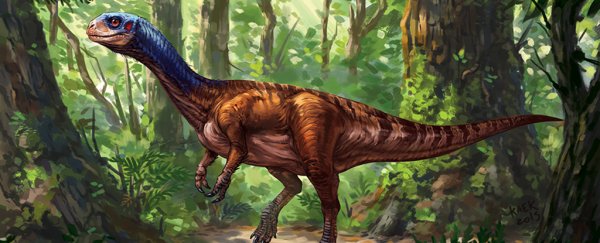A dinosaur we've only known about for a couple of years could be the missing link between plant-eating dinosaurs and members of the theropod group, including carnivores like Tyrannosaurus Rex and Velociraptor.
That's based on a new analysis of the Chilesaurus dinosaur – first identified in 2015 from a fossil find in Chile, it's intrigued researchers ever since with its odd mix of physical characteristics.
Not only does Chilesaurus bridge a rather large gap between the two biggest dinosaur groups, it also gives us clues about how that gap might have been created, according to the team from the University of Cambridge and the Natural History Museum in the UK.
"Chilesaurus is one of the most puzzling and intriguing dinosaurs ever discovered," says one of the researchers, Paul Barrett of the Natural History Museum.
"Its weird mix of features places it in a key position in dinosaur evolution and helps to show how some of the really big splits between the major groups might have come about."
 The dinosaur family tree may need rewriting. Credit: University of Cambridge
The dinosaur family tree may need rewriting. Credit: University of Cambridge
The dinosaur in question has a small skull, long neck, and a body measuring about 3 metres (or 10 feet). It's thought to have lived about 145 million years ago during the Jurassic Period.
The team analysed more than 450 anatomical characteristics of Chilesaurus to try and place it in the right part of the dinosaur family tree.
The two major dinosaur groups that Chilesaurus could bridge are the 'lizard-hipped' Theropoda group, including Tyrannosaurus rex, and the 'bird-hipped' Ornithischia group, including the likes of Triceratops.
It was originally thought that Chilesaurus belonged in the lizard-hipped group, but the new study suggests it's a very early member of the bird-hipped group instead.
Chilesaurus has inverted, bird-like hips, but it doesn't have the distinctive, bird-like beak for eating like all the other Ornithischia dinosaurs, such as Stegosaurus or Iguanodon, and that's what makes it so important to paleontologists.
And while its head resembles that of a carnivore, it has flat teeth best suited to grinding up plants. It's a mixture of mysteries.
"There was a split in the dinosaur family tree, and the two branches took different evolutionary directions," says one of the team, Matthew Baron from the University of Cambridge.
"This seems to have happened because of change in diet for Chilesaurus. It seems it became more advantageous for some of the meat-eating dinosaurs to start eating plants, possibly even out of necessity."
If Chilesaurus really is an ornithopod rather than a theropod, then it can help us understand how this group of dinosaurs developed. Based on the team's analysis, it looks like the gut of this dinosaur evolved before the jaw, for example.
And it means ornithopods and theropods are more closely related in the dinosaur family tree than previously thought. In other words, they had common ancestors, rather than evolving separately, and Chilesaurus is one of the earliest keys to that.
In the end it turns out that a dinosaur that had been seen as something of a Frankenstein's monster is actually one of the most significant we've identified so far.
"Chilesaurus almost looks like it was stitched together from different animals, which is why it baffled everybody," adds Baron.
The findings have been published in Biology Letters.
